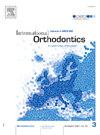In vitro comparison of the effects of direct attachment shape and location on forces and moments generated by thermoplastic aligners during simulated torque movement
IF 1.9
Q2 DENTISTRY, ORAL SURGERY & MEDICINE
引用次数: 0
Abstract
Introduction
The aim of this study was to investigate the effects of direct attachment shape and location on the forces and moments generated by thermoplastic aligners during simulated maxillary central incisor torque.
Materials and methods
A total of 7 typodonts were digitally printed with different attachment design and locations. Five clear aligners were fabricated for each typodont and placed on an orthodontic force tester (OFT) with the maxillary central incisor rotated palatally 1° around the incisal edge. Forces and moments were measured 2 times by the load cells. Analysis of variance (Anova) was used to determine the effects of group, tooth, and the group-by-tooth interaction on the outcomes; A two-sided 5% significance level was used for all tests. Analyses were performed using SAS version 9.4 (SAS Institute Inc., Cary, NC, USA).
Results
The two-way interactions between group and tooth were significant (P < 0.001) for all outcomes except facial/palatal moment around the X axis (Mx) (P > 0.05). The horizontal ellipsoid attachment at the middle third generated the highest Mx (−25.74 ± 8.93 Nmm) with facial crown/palatal root, while the rectangular attachment at the middle third yielded the lowest Mx (3.31 ± 12.92 Nmm).
Conclusions
Changing attachment shape and location had a significant effect on the forces and moments generated during simulated maxillary incisor torque. The best design for the incisor torque movement was found to be the horizontal ellipsoid attachment at the middle third. Besides the desired torque moment, all attachment shape and location combinations produced a vertical extrusive force as a side effect.
在体外比较直接连接的形状和位置对热塑性对准器在模拟扭矩运动中产生的力和力矩的影响
本研究的目的是研究在模拟上颌中切牙扭矩时,直接附着的形状和位置对热塑性矫直器产生的力和力矩的影响。材料和方法采用不同的附件设计和位置,对7个排字件进行数字印刷。为每个印型牙制作5个明确的对准器,并放置在正畸力测试仪(OFT)上,上颌中切牙沿切缘腭侧旋转1°。力和力矩由称重传感器测量2次。采用方差分析(Anova)来确定组、牙和组间相互作用对结果的影响;所有检验均采用双侧5%显著性水平。使用SAS 9.4版(SAS Institute Inc., Cary, NC, USA)进行分析。结果组与牙的双向交互作用显著(P <;0.001),除了X轴周围的面部/腭力矩(Mx) (P >;0.05)。面冠/腭根水平椭球状附着体的Mx值最高(- 25.74±8.93 Nmm),矩形附着体的Mx值最低(3.31±12.92 Nmm)。结论改变附着体形状和位置对上颌切牙模拟转矩产生的力和力矩有显著影响。结果表明,在中三分之一位置采用水平椭球体附着体是实现切牙力矩运动的最佳设计。除了所需的扭矩外,所有附件形状和位置组合都会产生垂直挤压力作为副作用。
本文章由计算机程序翻译,如有差异,请以英文原文为准。
求助全文
约1分钟内获得全文
求助全文
来源期刊

International Orthodontics
DENTISTRY, ORAL SURGERY & MEDICINE-
CiteScore
2.50
自引率
13.30%
发文量
71
审稿时长
26 days
期刊介绍:
Une revue de référence dans le domaine de orthodontie et des disciplines frontières Your reference in dentofacial orthopedics International Orthodontics adresse aux orthodontistes, aux dentistes, aux stomatologistes, aux chirurgiens maxillo-faciaux et aux plasticiens de la face, ainsi quà leurs assistant(e)s. International Orthodontics is addressed to orthodontists, dentists, stomatologists, maxillofacial surgeons and facial plastic surgeons, as well as their assistants.
 求助内容:
求助内容: 应助结果提醒方式:
应助结果提醒方式:


